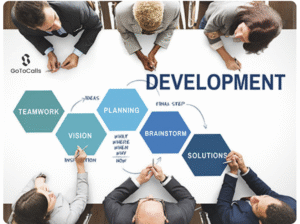When Outdated Roles Block Growth


Your business has grown, but your team’s roles haven’t.
That’s the quiet choke point most founders don’t see until the cracks start showing.
What used to be efficient when you had a small team now has everyone wearing multiple hats, tasks overlapping and quick Slack decisions. It starts turning into a silent drag on performance.
Projects stall, communication loops multiply and the CEO’s calendar becomes the company’s emergency inbox.
The problem isn’t effort. It’s structure.
When roles don’t evolve with the business, they create invisible friction, duplicated work, unclear accountability, and constant interruptions disguised as “quick questions.”
This is where leadership maturity gets tested.
Because at a certain stage, the biggest bottleneck isn’t your people’s capability, it’s the roles they’re stuck in.
A marketing lead still handling admin approvals.
A founder still managing client onboarding.
Everyone’s busy, but no one’s aligned.
That’s how growth plateaus, not from lack of hustle, but from lack of role clarity.
The Setbacks That Come With Outdated Roles

When a company keeps growing but the roles stay the same, it triggers a quiet crisis that doesn’t show up on financial reports, at least not immediately.
- Mental fatigue: Everyone feels overextended, but no one can pinpoint why.
- Decision fatigue: The CEO becomes the fallback for every unclear task.
- Execution fatigue: Teams work hard but hit the same roadblocks over and over.
This is how burnout hides in plain sight. Leaders start feeling guilty about taking a day off. Team members feel unseen because they’re stretched too thin. Meetings become more about coordination than creation.
In a McKinsey study on “The limits of RACI—and a better way to make decisions”, cites that 80 % of organizations report struggles with decision-making.
80% of companies reported that unclear responsibilities were the biggest source of inefficiency. The more a company grows, the more this clarity gap expands, until leadership decides to rebuild structure intentionally.
What Happens When You Grow Without Redefinition
Every scaling company reaches a “redefinition point.” It’s the moment when yesterday’s structure can no longer carry tomorrow’s goals. We talked about this on linkedin recently.
If you’ve noticed these signs, you’re likely at that point:
- You’re still approving every task “just to be safe.”
- You get copied in on every conversation.
- You’re the one catching dropped balls.
- Your day is filled with putting out fires instead of building strategy.
This isn’t a discipline problem. It’s a design problem.
You’re running a new business on an old map.
Think of it like a building that’s been expanded without redoing the foundation. The new floors look impressive, but the structure underneath is still built for something smaller.
That’s what happens when roles don’t evolve: growth looks visible from the outside but unstable from within.

Why CEOs Lose Time (and Trust) in the Transition
Most founders don’t cling to control because they love micromanaging. They do it because they fear things falling apart.
When roles are outdated or unclear, trust erodes. You start thinking, “If I don’t review this, it’ll get missed.”
So instead of spending time on vision, partnerships, and growth, you’re buried in approvals, edits, and oversight.
Time management for CEOs isn’t really about better scheduling.
It’s about redistributing ownership.
Until you build a team structure that makes accountability visible, time will always feel scarce.
The best CEOs don’t just manage time but engineer it through clarity.
So the next question is how do I improve role clarity in my team?
1. Redefine Roles Around Outcomes, Not Tasks
The first step isn’t to hire more people. It’s to clarify what each role actually owns.
Instead of asking, “Who can help me with this?”, ask, “Who should be responsible for this result?”
- Old structure: “Who’s sending that email?”
- Modern structure: “Who owns communication with this client segment?”
When roles are defined by outcomes, not actions, you build autonomy into the system. Everyone knows what success looks like, without constant supervision.
Tip: Revisit every key role and write one simple statement for each:
“This role is responsible for achieving X, by doing Y, with the support of Z.”
That’s the foundation of clarity-driven delegation.
2. Delegate for Scale, Not Relief
Most leaders delegate only when they’re overwhelmed. That’s reactive delegation and it gives you short-term relief, but not long-term freedom.
Proactive delegation looks different. It’s about intentionally moving recurring, non-strategic tasks off your plate before they become bottlenecks.
Start with:
- Inbox and scheduling management
- Project follow-ups
- Recurring client communication
- Administrative approvals
Then gradually expand toward delegation that scales leadership:
- Metrics reporting
- Meeting prep
- Research and documentation
When you transfer ownership with clarity, delegation becomes a growth strategy and not just an escape plan.
That’s where the virtual assistant ROI compounds; buying back leadership attention.
3. Build a Clarity System
High-performing teams don’t stumble into alignment; they design it.
A clarity system has three parts:
- Defined Roles: Every team member knows what they’re accountable for.
- Documented Processes: Every recurring task has a clear path to completion.
- Delegation Loops: Feedback and updates flow automatically, without chasing.
This is the infrastructure behind freedom.
When clarity systems exist, accountability becomes self-sustaining, you don’t have to enforce it, it’s built in.
That’s what GoToCalls helps leaders build: a structure that allows them to step back without the team stepping down.
4. Measure Time Like an Investment Portfolio
Most CEOs measure revenue but not return on time.
Yet, time is the most expensive resource in a business.
If you’re spending ten hours a week on low-value tasks that could be delegated for $25 an hour, that’s a $1,000 weekly loss of strategic capacity.
Time management for CEOs is about multiplying impact.
That means:
- Auditing where time actually goes
- Categorizing tasks by value tier
- Assigning ownership to match skill and ROI
This shift reframes delegation from cost to investment.
5. Lead Through Systems, Not Supervision
The best leaders are the ones who design themselves out of the bottleneck.
Once roles are updated and clarity is in place, your leadership role shifts from “approver” to “architect.”
You don’t manage people, you manage the environment that helps them thrive.
That’s what a sustainable scale looks like.
Growth isn’t blocked by lack of opportunity; it’s blocked by outdated definitions of responsibility.
When you redefine roles, document systems, and delegate with clarity, you free up your time and your team’s potential.
That’s how the best CEOs scale.
Not through control, but through clarity.
And that’s exactly what GoToCalls helps leaders build:
The systems that turn freedom into the new normal.


